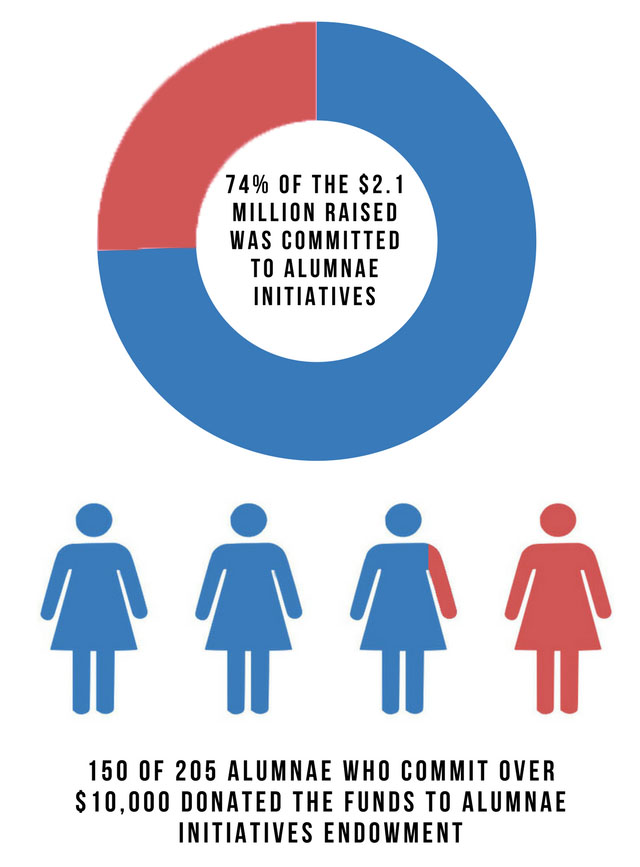The newly founded Society of 1918 seeks to engage with women graduates of the College of William and Mary and encourage them to give significant contributions. Charter members of the Society of 1918 — any alumna who pledges $10,000, up front or over the course of five years — will be accepted until June 2018.
The Society of 1918 is the product of a nearly six-year endeavor on the part of the William and Mary Alumni Association and a small group of alumni who formed the Task Force on Women and Philanthropy. Together, they analyzed national data alongside their own focus group research of the College’s alumnae to devise a strategy to better engage women donors.
According to University Advancement writer Claire De Lisle, in order for one to join the Society of 1918, one must contribute a minimum of $10,000 in the form of a membership fee. De Lisle said that Duke University requires a $100,000 donation for a similar organization, while other universities do not require philanthropy but instead require participation.
At $10,000 we really wanted to celebrate significant women’s philanthropy and to recognize and point out those women who are giving at their highest level of capacity,” De Lisle said. “Now that said, one of our subcommittees is membership: how do we engage women who can’t give at this level, maybe not as members of the Society, but how do we engage them?”
“At $10,000 we really wanted to celebrate significant women’s philanthropy and to recognize and point out those women who are giving at their highest level of capacity,” De Lisle said. “Now that said, one of our subcommittees is membership: how do we engage women who can’t give at this level, maybe not as members of the Society, but how do we engage them?”
According to De Lisle, members of the organization are involving students and other alumnae who are not members of the Society through events, such as the “William and Mary Women: All Aboard!” event, which seeks to engage women through leadership and more moderate donations.
Vice Chair of the Society of 1918 Janet Atwater ’84 said that in order to account for potential problems of inaccessibility, the $10,000 donation is over a period of five years rather than up front. There is also an opt-in option for previous donors.
“Obviously that excludes folks that don’t have the ability to give $2,000 a year,” Atwater said. “We are making sure that we are doing programming that is not just for Society members but will impact the greater community … such as the William and Mary weekend next September.”
Currently at the College, over half of the student body is comprised of women, with the most recent class of 2021 at 58 percent women. Similarly, women represent 53 percent of alumni at the College. According to Director of Alumni Initiatives Val Cushman and De Lisle, women graduates are more likely to make a donation of any amount than men, citing that they have given more on One Tribe One Day than men, but noting that on average, the amount women give is significantly lower than men.

“Men are more interested in the professional benefits of being philanthropic,” De Lisle said. “They’re more interested in the tax ramifications of being philanthropic, while women are more interested in the impact of the gift. So, they need to understand the vision of where they’re going, and they need to understand if they do give something what happens with those dollars, whether it’s one or a million is it making a difference. And that matters to women.”
Cushman said that for many female donors, giving is about building relationships.
“[For women] it’s about building these relationships with students, but also faculty, the staff, the peers, being able to connect with other alumni and forging those bonds, and really seeing the impact of their gift on people,” Cushman said.
Chair of the Society of 1918 Fran Engoron ’70, who is also a board member involved in philanthropy with the Raymond A. Mason School of Business, said that she donates with students in mind.
“My criteria [are] more student-focused,” Engoron said. “If we want to significantly increase philanthropy from women, we have to increase student engagement.”
Atwater said that the Society plans on advocating for women in positions of leadership, including faculty positions.
I think one of the things we’re really trying to do is increase parity on the various leadership boards around campus, making sure we’re advocating for women in senior leadership positions, advocating for greater numbers of women professors, et cetera,” Atwater said.
“I think one of the things we’re really trying to do is increase parity on the various leadership boards around campus, making sure we’re advocating for women in senior leadership positions, advocating for greater numbers of women professors, et cetera,” Atwater said.
Vice President of University Advancement Mathew Lambert ’99 said that the College is among the first five universities in the country to focus specifically on women’s philanthropy and is currently being studied for best practices in fundraising.
“Our goal is to grow engagement, which leads to growing leadership, which results in growing philanthropy,” Lambert said in an email.

